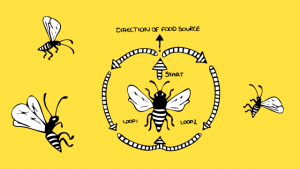Humans have used bees for millennia. So precious to the ancient Egyptians was honey that they entombed it in the pyramids, a gift to their revered dead. However, until recently attempts at understanding honeybee genetics had been fairly modest. Even the ‘Father of Genetics’, Gregor Mendel, only got as far as creating some very bad tempered hybrids before concluding that pea plants were much more suitable subjects for his studies. Now though, as the ‘Genomics Revolution’ continues to take hold, the biology of the honeybee is being probed in more detail than ever before by researchers from a wide range of fields, from molecular biology to anthropology.
In 2006 the first completed draft of the genome—the entire genetic information—of Apis mellifera, the western honeybee, was released, creating a huge buzz in the research community—and for good reason. As the main pollinator of insect-pollinated crops, the honeybee has immense economic importance, and without them our diets would be very much sparser.
We have more reasons to be interested in bees though. Whilst we humans flatter ourselves that we are by far the most advanced creatures on the planet, other life forms display impressive sophistication, with bees coming very high up the list. As the only non-primates to use a symbolic language to communicate, they live in breathtakingly complex ‘eusocial’ colonies. These communities have striking similarities with the social groups of numerous primate species, including our own. The hive works communally to care for offspring and defend the colony. Even sourcing sustainance is a team effortwith bees indicating the direction of food to each other by the affectionately termed “waggle dance”. Honeybees therefore act as model systems for our own communities and interactions and are hence ideal for helping us answer questions about sociality. How did it arise? At the genetic level, what makes social life forms special? Do honeybees share specific genetic features with other eusocial animal groups? The genome sequence has provided a firm foundation for studies which aim to provide answers to these questions.
Developmental biology is another field which will benefit from the publication of the bee genome. Already, data from the genome has been used to answer a mystery which has long puzzled beekeepers and scientists alike—the way in which royal jelly, when fed to larvae, causes them to become long-lived, large, reproductive queens rather than short-lived, small, sterile ‘default’ workers. Royal jelly, the study reveals, causes changes to DNA itself. Although the units which make up the DNA remain the same, the addition or removal of methyl groups (CH3) to the DNA can affect the extent to which genes are switched on or ‘expressed’. Moreover, this ‘epigenetic’ modification of DNA can be inherited through cell divisions, and is now recognised as an immensely important factor in development. In queens, it seems, the distribution of methyl groups is very different to that in workers, with over 500 genes being differentially methylated between the two castes. Further analysis of these genes will no doubt lead to more detailed understanding of their roles in creating and maintaining the differences between queens and workers. In addition, this work has also revealed that methylation can modulate not only how active a gene is but even the form or type of protein encoded, a mode of regulation hitherto completely unknown in any organism.
Another fascinating insight into bee biology from the genome sequence is the accompanying data on gene expression. It has been known for decades that the tasks performed by bees vary according to age; young bees tend to stay in the hive and care for the developing larvae while their older nestmates fulfil the colony’s foraging needs. Only now can we see that these different tasks are mirrored at a genetic level by changing the activities of various genes. Genes, it would seem, are central to the day-to-day behaviour of bees.
The publication of the honeybee genome was just the start of a flood of information about this enthralling creature and the results of new studies are rapidly springing forth. There is no doubt that the bee genome has many more secrets to give up; it is clear there is much more to bees than honey!
![A Sweet Combination Humans have used bees for millennia. So precious to the ancient Egyptians was honey that they entombed it in the pyramids, a gift to their […]](/wp-content/uploads/2011/10/A-sweek-combination_preview-620x300.png)
